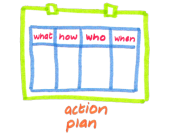 If you are looking to write a book, produce audio, video, or online assets, package a coaching or consulting program, or otherwise "productize" your expertise, keep reading... you'll like this post.
If you are looking to write a book, produce audio, video, or online assets, package a coaching or consulting program, or otherwise "productize" your expertise, keep reading... you'll like this post.
You're getting a simple, repeatable process for guess-free product development that ensures you only create products that your target market will be eager to buy.
Here is your 7-step process in a nutshell: Scan, Survey, Analyze, Productize, Test, Package, Deliver.
Scan is step 1 and it's simple – do a competitive scan and see what else is out there that solves – or claims to solve – the same pains, problems, heartaches and headaches as your brilliant product or program. We’ll come back to that “claims to solve” issue a little later. But you have to know what alternative and competing products are out there. Otherwise, you’ll have a very hard time with articulation and distinction.
Survey is step 2 – you must survey members of your target market. When I work with folks individually or in groups, we do a very detailed survey step and you get models and templates of surveys that I’ve used and my clients have used with great success. The questions are simple – which of these aspects of the problem are most urgent for you? What are you looking to solve? What have you tried to solve it so far? Why hasn’t that worked? What would a “dream solution” look like that addresses everything you need solved?
Analyze is step 3 – this is where you collect and collate all the data you’ve received using simple tools like Survey Monkey or Zoomerang.com. I also strongly recommend more personal interviews during the analyze step where you can spend quality time with folks in your target market and learn more intimate details of what they are up against when dealing with your area of expertise. You need to go deep here – find the issues behind the issues. Surface the deeper needs that lie beneath the waterline of the iceberg that everyone else is claiming to help them with. This will put you miles ahead when it comes to offering what I call the “Ah, at last” solution.
Step 4 is Productize – this is where you start to put the pieces together. There are 2 parts to productize – one is writing zero-draft marketing copy. This is the skeleton of bullets, sound bites and short phrases that capture what your product does, what it means to them, why it’s FSB – faster, smarter, better than anything else out there. The second half of productize is to put the skeleton product out there – what I call the bones of your product – the snippets, scripts, tools, templates, worksheets, checklists, forms and other raw material – powerpoints, pdfs, whatever you have to throw at this thing, just make a big folder and put it all in there. Just do THAT, and your product will be between 50%-80% done.
All that’s left is editing, pruning, organizing and sequencing. Again, we have a system and a method for doing this, which you’ll gain access to if we work together. You’ll get more details on that later. (No pressure - I'm not selling it to you. It just happens to be awesome.)
Step 5 is Test. Testing is critical for 2 reasons – first, you’ll test your beta product with real, live prospects. The sound bite is this – "I’m in the process of developing a new product to address problems X, Y, and Z. Because you’re someone whose opinion I respect, may I send you the beta or draft product? I’d love to get your advice, insights and recommendations on how to make it better and more valuable."
You’re doing two things in this step – you’re doing live ammo testing AND you’re doing pre-marketing to folks in your exact target market. Sweet!
Step 6 is Package. The packaging step is both internal and external – internally, you are packaging up the final product. Edits, revisions, improvements based on your surveys and feedback. You’re making important enhancements that will make your product both more saleable and more valuable.
Externally, you’re working on the physical packaging if it’s a product (things like book cover design, CD or DVD packaging, graphics, and so on) and the marketing packaging. You’re revising your Zero-Draft marketing copy and making adjustments to what you’re promising to solve based on the feedback and the urgencies and priorities you’ve uncovered in your target market.
Finally, Deliver is Lucky #7. It’s game time – you’re primed, your pumped, your packaged. This is where you begin to offer your product for sale. It’s back of the room sales, online sales, you start to bundle and supersize your product with other products or programs you’re already selling. And, of course, if it’s a coaching or consulting package then you are literally also starting to DELIVER the program with your first batch of clients and customers with whom you’re working.
This process is simple – but not easy. Each step can take you anywhere from a week to a month, or sometimes more. You may need various people on your team to help speed the process. A ghostwriter, editor, graphic designer, web master, audio or video editing folks, a fulfillment company. When I work with people in the Product Development Toolkit, we work through all of this together to take away the overwhelm.
Another bonus that you’ll often find is that as you work through this process, you’ll sometimes come out the other side not with ONE product but possibly with TWO or THREE products.
The process lends itself to that. Maybe you end up with a version for men and for women. Or for salespeople and sales managers. Or for leaders and team members. There are often two or more sides to any type of product or program and these naturally emerge from the product development process as you’re going through it.
I’ll give you an example from my world.
When I wrote my first book, it was called Relish. It was a book about success in different areas of life - personal, professional, business, career, relationships, etc. As I was writing it, it started getting very top-heavy on the business side. I then realized I had enough content for two books, not one – so I published Relish and Relish for Business.
Same thing happened a few years later when I wrote my book Unconsulting. It was written for consultants, entrepreneurs and executives. Then I realized, I was writing and talking a lot with executives who hired consultants. So the second book project emerged, and this was actually my first book with a real publisher, HRD Press. That collection of advice to executives became The Manager’s Pocket Guide to Using Consultants. So just remember to be open to that possibility of your second or third product naturally emerging from your work on the first one.
Good news - and shocking coincidence: The next Product Development Toolkit group program begins February 5.
But it's not for you.
You wouldn't like it.
So don't even bother going over there to that page.
It is meant for OTHER people, not you.
Seriously.
Whew - that was close!! Now please feel free to LEAVE A COMMENT below to share your experiences with developing high-value information products that package and promote YOUR expertise...
 As a marketing speaker and marketing coach, I get a ton of questions about LinkedIn.
As a marketing speaker and marketing coach, I get a ton of questions about LinkedIn.



 Guest column by Ryan Pinkham, Engagement Marketing
Guest column by Ryan Pinkham, Engagement Marketing Let’s talk about YOUR product development strategy. This is about creating products with intention. And let me back up a step and define what I consider “creating a product” to be.
Let’s talk about YOUR product development strategy. This is about creating products with intention. And let me back up a step and define what I consider “creating a product” to be. Here's another in my series of marketing and business book reviews - but not just any old business books.
Here's another in my series of marketing and business book reviews - but not just any old business books. If you are looking to write a book, produce audio, video, or online assets, package a coaching or consulting program, or otherwise "productize" your expertise, keep reading... you'll like this post.
If you are looking to write a book, produce audio, video, or online assets, package a coaching or consulting program, or otherwise "productize" your expertise, keep reading... you'll like this post.  Snappy.
Snappy. No step is too small...
No step is too small...